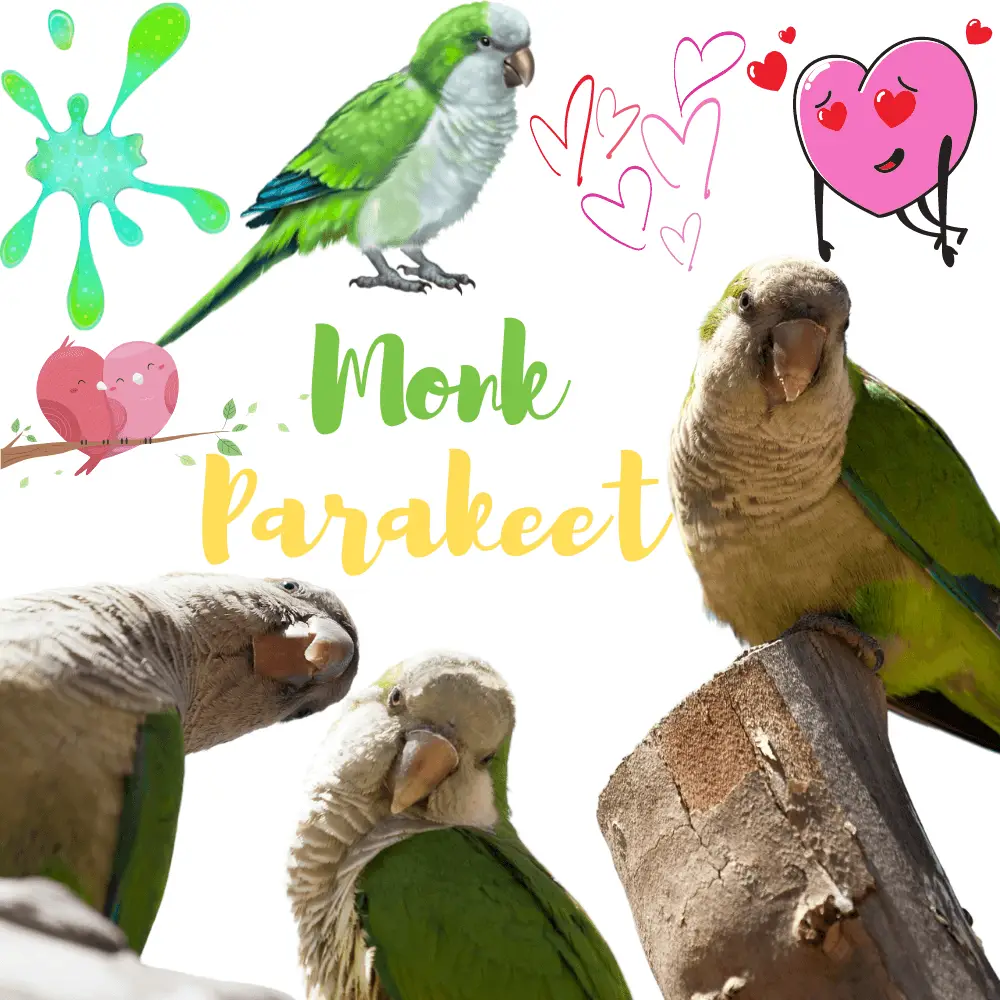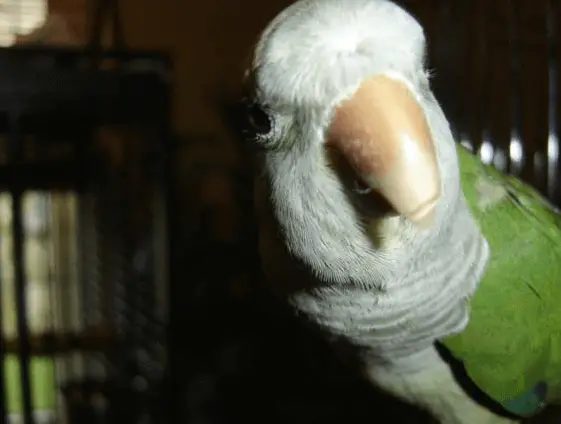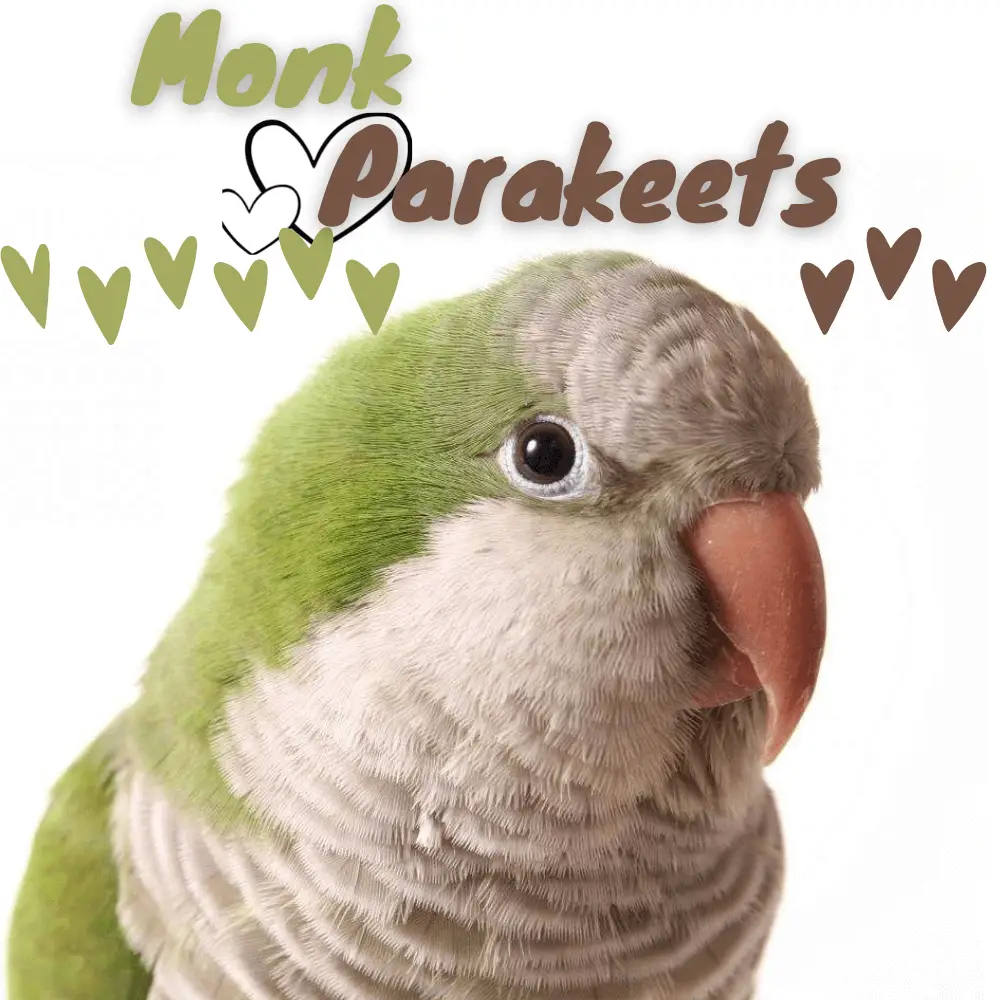Monk Parakeets have also known as the Quaker parrot adorable little green monsters! Monk parakeet, mouse parakeet, and widow conure are the names used in French to name the Myopsitta monachus.
Very often, in Quebec, its English name is used: “Quaker”. It is a bird that is native to central South America, more precisely, Brazil, Paraguay, Argentina, and neighboring countries.
In Europe, Asia, the United States as well as Central America, and the West Indies, there are large, well-established colonies.
Recognized Subspecies, Ranges and IDs
- Myiopsitta monachus monachus (Boddaert, 1783)
- Myiopsitta monachus calita (Boddaert, 1783)
- Myiopsitta monachus cotorra (Finsch, 1868)
- Cliff Parakeet, Myiopsitta (monachus) luchsi (Boddaert, 1783)

How can this be possible? The most plausible hypothesis is that these colonies developed from a few individuals who escaped into the wild by humans and have succeeded in establishing themselves thanks to their resourcefulness and their great ability to adapt to climates and habitats. different.
This bird is so hardy that it can survive the winter (perhaps not a Quebec winter, however). In several countries, the monk parakeet is talked about; it can rob native bird habitats and ravage fields when a colony decides to go foraging. Unfortunately, it does not have a very good reputation.
Medium in size, it measures 30 cm and its mass is usually around 150 g. It is green with a pale gray forehead and breast, and its bill is pinkish beige.
Its wings are a bit more colorful, as its flight feathers are a turquoise blue. Man, by dint of breeding them, has succeeded in developing monk parakeets of different mutations, but apart from blue rather than green individuals, these parakeets are very difficult to find on the market.
They do not have sexual dimorphism, which means that you cannot tell if they are males or females from their appearance. Their life expectancy is around thirty years.
Monk parakeets are amazing birds
They gather, in a small size, the equivalent of a gray for its ability to speak, a macaw for its energy, and an amazon for its temperament.
They are intelligent, funny, playful, curious, very dynamic, and above all spectacular talkers.
Mice parakeets are particularly active and curious. They will always find a place to discover in the house, a toy to disassemble, or a cage door to open. Their antics are incessant and that makes all their charm.
Origins of the Quaker Parakeet
The monk Parakeet (Myiopsitta monachus) more commonly known as the Widow Parakeet, is a bird of the order Psittaciformes and the family Psittacidae like other species of parakeet. This parakeet is native to South America, including Brazil, Paraguay, and Argentina, and is now also established in the United States and parts of Europe. Indeed, this bird is observable in some parks in Spain and even in France, more precisely in the south, as well as in Italy.
Physical characteristics
All you need to know about this beautiful bird
Weight and size
Weight: between 150g and 200g
Height: between 25 and 29 cm
Plumage
The quaker Parakeet sports light green plumage on the top of the body while its chest and head are light gray, which is why it is named. Its feathers (large flight feathers that make up its wings) are a beautiful metallic blue or turquoise, just like its tail. Its tricolor plumage makes the monk Parakeet a bird whose beauty is undeniable.
Overall appearance
The quaker Parakeet remains a small parakeet, like other birds of its species, but it is no less robust.
Its thick hooked bill is beige or pale brown. Its eyes are black and its legs are gray.
There is no sexual dimorphism in the monk Parakeet, only a DNA test will determine the sex of the bird. Nevertheless, the male appears slightly larger than the female.
The juvenile quaker parakeet has much brighter plumage than older mice, and its forehead is also green. It is only as it grows that its plumage tarnishes and its head becomes grayish.

The character of the quaker Parakeet
The monk Parakeet is a real miniature parrot that combines the character of the Gabonese Grey, the Macaw, or the Amazon. Intelligent, curious, and playful but also dynamic, this little parakeet is always in a good mood and has everything to please.
This bird is a real little clown, offer him some toys and watch him have fun and do antics for hours, show guaranteed! Her curiosity makes the Parakeet able to occupy herself alone, for the little she has something to enjoy, so she will not be bored during the absence of her masters. Nevertheless, giving her attention is important, she also tends to create strong links with her masters.
Its only disadvantage is its territoriality: approaching its cage may be difficult and it will not hesitate to attack you. It will be necessary to know how to be dominant from the beginning.
What makes the monk Parakeet so exceptional is above all its great ability to speak, almost as well as a Gabonese Grey! Unlike other parakeets of its kind, the quaker is able to imitate the sounds it hears and repeat them quite audibly. Be careful, however, if you are looking for a bird that is not very noisy, the quaker Parakeet has a very shrill voice.
The health of the monk Parakeet
All you need to know about quajer parrot health
Life expectancy
Monk Parakeet Lifespan:The monk parakeets’ longevity in captivity is about 30 years.
The life expectancy of the quaker Parakeet is 30 years in the best living conditions.
Common health problems
As with all parakeets and domestic parrots, the quaker Parakeet is prone to common diseases that can be fatal if not treated in time, including:
- Beak and feather disease (PBFD), whose symptoms are an infection in the plumage causing feather loss and difficulty regrowth as well as abnormalities in the beak and legs. This patient can lead to hepatitis and several other diseases. PBFD is a disease that is unfortunately incurable today.
- Psittacosis, is a disease contagious between birds but also transmissible to humans caused by a microorganism Chlamydia psittaci. Symptoms include tremors, weight loss, difficulty breathing, and diarrhea. In humans, the disease is similar to a flu-like state.
- Pacheco’s disease, herpes that can affect all birds and is often fatal whose symptoms are lethargy, diarrhea, abnormal urine, and anorexic.
Care of the monk Parakeet
All about Quaker parrot care
Lifestyle
The quaker Parakeet being a very dynamic bird, it must have at its disposal a large space in order to be able to exercise. Ideally, we recommend a large aviary or failing that, a large cage with a life in semi-freedom to give him the opportunity to stretch his wings.
We will also think about providing her with something to take care of with different toys so that she has enough activities at her disposal.
Feeding
In captivity, the monk Parakeet feeds on seed mixtures for parakeets or parrots found in pet stores. We will complete the diet with fruits and vegetables, not to mention a cuttlefish bone to offer all the minerals essential for good health.
Monk Parakeets Diet:As a companion bird, the monk parakeet is similar to most parrots and the care given to it is the same. It has a granivorous staple diet, which must be supplemented with fruits, vegetables, cheese, sprouted grains, extruded foods, etc.
Outings to stretch your wings are essential, every day. If your monk parakeet is happy, she will be an adorable and surprising companion.
She is very good at learning to imitate sounds and short sentences, she is funny and her curiosity knows no bounds; she is not afraid of anything.
Several contradictory testimonies are reported about his personality. On the one hand, she is adored and portrayed as a clever and cuddly clown and, on the other, she is hated and portrayed as an aggressive monster and tyrant.
Care and grooming
The Parakeet likes to be able to bathe or take showers and share this moment with his master. You can offer him a bath directly in his cage or in a sink or bathtub with it, but this activity should not be done unsupervised.
Some love to take showers by having water sprayed on the plumage and will spread their wings wide to enjoy it.
Monk Parakeet Breeding

Second peculiarity: they are gregarious birds. The colonies live in “condos”; hundreds of families build their nests from that of their neighbors.
Communication is essential between neighbors and we can distinguish different “dialects” from one colony to another. The essential tool for communication is the voice.
Our little monk parakeet has a tendency to develop it with talent and to use it to call us… with force. Here too, we find two sides to the coin:
it has a whole charm when it imitates sounds, when it speaks, and when it sings, but it loses a little of its charm when it feels abandoned and when she expresses her indignation by shouting at the top of her voice in the house.
The monk parakeet is one of the most misunderstood parrots. Too often, a bird raised in the wrong conditions will develop bad habits, which will lead to an escalation of calls and bites.
Then the family will begin to fear it, reduce interactions and limit exits from the cage. This will have the effect of making the Monk Parakeet sick from loneliness and, as it is a species that tends to peck (pluck), other problems will develop. Unfortunately, stories like this, in the case of monk parakeets, in particular, are very common and lead to neglect.

Yet this kind of drama can be avoided. It must be understood that the monk parakeet needs its colony. It is essential that she does not become attached to a single human, and it is for this reason that all human members of her colony should take the time to handle, play with, and feed her so that she develops affinities with several people.
In addition, it is advisable to provide him with several places equipped with different toys in the house. This way, she is less likely to become possessive of her toys and cage, as well as to develop territorial behaviors.

Monk Parakeets
Understanding how our parrot works and adapting life in captivity to meet its needs are the first steps towards a healthy relationship with it.
If we don’t have enough time to devote to our monk parakeet, we will never be able to develop this relationship of trust with her. On the other hand, if we invest a little in it, this bird will become the playful and cuddly little clown that we hear about.
Monk Parakeets Nest
SOURCE:Cornell Lab of Ornithology
First, one of the peculiarities of its species, which greatly influences its behavior, is its taste for construction. While the majority of parrots seek a hollow in a tree to set up their nest, our monk parakeet builds a complex nest for itself.
Its buildings are small architectural gems and real apartments! In fact, the nests of these birds are divided, most of the time, into three different rooms: a room for laying and hatching, a living room for the little ones when they have grown up, and an entrance hall that allows being for guard.
When the monk parakeet is found in captivity, this behavior is written into its genes and results in very, very marked territoriality.
It can be funny to watch him move objects around in his cage to decorate to his liking, but it’s no longer funny when our adorable companion turns into a ferocious beast and attacks any hand wanting to approach his cage. It is said that the smaller her cage, the more jealously she will guard it.





















